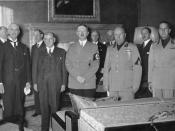In the Berlin Diary, many types of leadership were exhibited in the democracies of France, Great Britain, and the United States of America. In this paper, I will identify the leaders of this very violent period, and attempt to analyze each democracy's leadership as it relates to World War II.
FRANCE AND DALADIER
On his second go-around as Premier of France, Edouard Daladier was faced with a minor crisis in which he failed to make a decision. He had given permission for demonstrations to take place at the Place de la Concorde, which turned violent. Daladier had government troops standing by, but refused to use them, ultimately resulting in 16 deaths and several hundred people being wounded. Daladier resigned later that day. This type of leadership was pure cowardice. He was an exoskeletal leader; hard on the outside, soft in the middle, and couldn't make a timely decision. When he decided to act, it was too late.
The spinelessness of Daladier and Neville Chamberlain of Britain are two of the reasons why Hitler remained so powerful. This brings me to the second democracy of the era, Great Britain.
GREAT BRITAIN AND CHAMBERLAIN
Great Britain's Prime Minister, Neville Chamberlain was from the same basic mold as Daladier. He was pretty much a pushover, who thought that he was the bully. With the naval superiority that Great Britain had, Chamberlain probably could've done serious damage to the Axis. But like Daladier, Chamberlain didn't have the guts to stand up for his country. Great Britain's navy was by far the most superior, superficial navy in Europe. Why didn't he attempt taking on the Axis? Why didn't Daladier and Chamberlain initiate a plan to try and stop Hitler?
The answer: they were both spineless leaders who were scared and unprepared to fight a war.



World war 1
the story is good which creat emotional.i was the one who was in that condition.
1 out of 1 people found this comment useful.